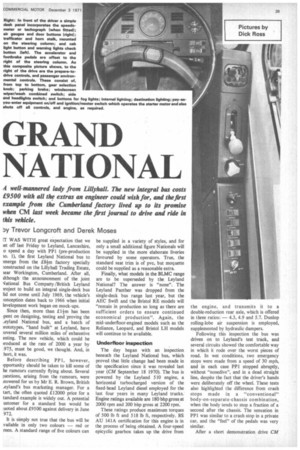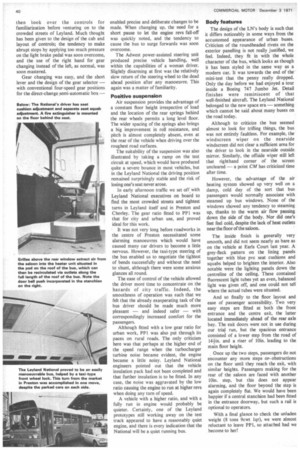GRAND NATIONAL
Page 41

Page 42

If you've noticed an error in this article please click here to report it so we can fix it.
A well-mannered lady from Lillyhall. The new integral bus costs £9500 with all the extras an engineer could wish for, and the first example from the Cumberland factory lived up to its promise when CM last week became the first journal to drive and ride in this vehicle.
by Trevor Longcroft and Derek Moses
7 WAS WITH great expectation that we iet off last Friday to Leyland, Lancashire, o spend a day with PP1 (pre-production io. 1), the first Leyland National bus to ;merge from the £84m factory specially mnstructed on the Lillyhall Trading Estate, tear Workington, Cumberland. After all, dthough the announcement of the joint Vational Bus Company /British Leyland )roject to build an integral single-deck bus lid not come until July 1969, the vehicle's :onception dates back to 1966 when initial levelopment work began on mock-ups.
Since then, more than£l--m has been pent on designing, testing and proving the _eyland National bus, and a batch of irototypes, "hand built" at Leyland, have :overed several million miles of exhaustive esting. The new vehicle, which could be woduced at the rate of 2000 a year by 1975, must be good, we thought. And, in bort, it was.
Before describing PP1. however, pportunity should be taken to kill some of he rumours currently flying about. Several luestions, arising from the rumours. were inswered for us by Mr E. R. Brown, British „eyland's bus marketing manager. For a tart, the often quoted £12000 price for a tandard example is widely out. A potential ustomer for a standard bus would be iuoted about £9500 against delivery in June 972.
It is simply not true that the bus will be vailable in only two colours — red or reen. A standard range of five colours can be supplied in a variety of styles, and for only a small additional figure Nationals will be supplied in the more elaborate liveries favoured by some operators. True, the standard seat trim is of pvc, but moquette could be supplied as a reasonable extra.
Finally, what models in the BLMC range are to be superseded by the Leyland National? The answer is "none". The Leyland Panther was dropped from the single-deck bus range last year, but the AEC Swift and the Bristol RE models will "remain in production so long as there are sufficient orders to ensure continued economical production". Again, the mid-underfloor-engined models such as the Reliance, Leopard, and Bristol LH models will continue to be available.
Underfloor inspection
The day began with an inspection beneath the Leyland National bus, which proved that little change had been made in the specification since it was revealed last year (CM September 18 1970). The bus is powered by the Leyland 510 engine, a horizontal turbocharged version of the fixed-head Leyland diesel employed for the last four years in many Leyland trucks. Engine ratings available are 180 bhp gross at 2000 rpm and 200 bhp gross at 2200 rpm.
These ratings produce maximum torques of 500 lb ft and 518 lb ft, respectively. BS AU 141A certification for this engine is in the process of being obtained. A four-speed epicyclic gearbox takes up the drive from the engine, and transmits it to a double-reduction rear axle, which is offered in three ratios: — 4.3, 4.9 and 5.7. Dunlop rolling-lobe air suspension is employed, supplemented by hydraulic dampers.
Following this inspection the bus was driven on to Leyland's test track, and several circuits showed the comfortable way in which it rode over the worst pieces of road. In wet conditions, two emergency stops were made from a speed of 30 mph, and in each case PP1 stopped abruptly, without -nosedive", and in a dead straight line, despite the fact that the driver's hands were deliberately off the wheel. These tests also highlighted the difference from crash stops made in a "conventional" body-on-separate-chassis combination, when the body tends to stop a fraction of a second after the chassis. The sensation in PPI was similar to a crash stop in a private car, and the "feel" of the pedals was very similar.
After a short demonstration drive CM then took over the controls for familiarization before venturing on to the crowded streets of Leyland. Much thought has been given to the design of the cab and layout of controls; the tendency to make abrupt stops by applying too much pressure on the light brake pedal was soon overcome, and the use of the right hand for gear changing instead of the left, as normal, was soon mastered.
Gear changing was easy, and the short lever and the design of the gear selector — with conventional four-speed gear positions for the direct-change semi-automatic box —
enabled precise and deliberate changes to be made. When changing up, the need for a short pause to let the engine revs fall-off was quickly noted, and the tendency to cause the bus to surge forwards was soon overcome.
The Adwest power-assisted steering unit produced precise vehicle handling, well within the capabilities of a woman driver. Slightly disarming at first was the relatively slow return of the steering wheel to the dead ahead position after any manoeuvre. This again was a matter of familiarity.
Positive suspension Air suspension provides the advantage of a constant floor height irrespective of load and the location of the rear springs behind the rear wheels permits a long level floor. The wider spacing of the springs also brings a big improvement in roll resistance, and pitch is ahhost completely absent, even at the rear of the vehicle when driving over the roughest road surfaces.
The suitability of the suspension was also illustrated by taking a ramp on the test circuit at speed, which would have produced quite a severe bounce in most vehicles, but in the Leyland National the driving position remained surprisingly stable and the risk of losing one's seat never arose.
In early afternoon traffic we set off. with Leyland National executives on board to find the most crowded streets and tightest turns in Leyland itself and in Preston and Chorley. The gear ratio fitted to PP1 was that for city and urban use, and proved ideal for this work.
• It was not very long before roadworks in the centre of Preston necessitated some alarming manoeuvres which would have caused many car drivers to become a little nervous. However, the taxi-type steering of the bus enabled us to negotiate the tightest of bends successfully and without the need to shunt, although there were some anxious glances all round.
The ease of control of the vehicle allowed the driver mord time to concentrate on the hazards of city .traffic. Indeed, the smoothness of operation was such that we felt that the already exasperating task of the bus driver should be made much more pleasant — and indeed safer — with correspondingly increased comfort for the passengers.
Although fitted with a low gear ratio for urban work, PP1 was also put through its paces on rural roads. The only criticism here was that perhaps at the higher end of the speed range when the turbocharger turbine noise became evident, the engine became a little noisy. Leyland National engineers pointed out that the vehicle insulation pack had not been completed and that further insulation is to be fitted. In any case, the noise was aggravated by the low ratio causing the engine to run at higher revs when doing any turn of speed.
A vehicle with a higher ratio, and with a fully run in engine would probably be quieter. Certainly, one of the Leyland prototypes still working away on the test track appeared to have a reasonably quiet engine, and there is every indication that the National will be a quiet running bus.
Body features
The design of the LN's body is such that it differs noticeably in some ways from the accustomed appearance of urban buses. Criticism of the roundheaded rivets on the exterior panelling is not really justified, we feel. Indeed, they fit in with the whole character of the bus, which looks as though it has been styled in the same way as a modern car. It was towards the end of the mini-test that the penny really dropped. Only the day before we had enjoyed a tour inside a Boeing 747 Jumbo Jet. Detail finishes were reminiscent of that well-finished aircraft. The Leyland National belonged to the new space era — something which cannot be said about many buses on the road today.
Although to criticize the bus seemed almost to look for trifling things, the bus was not entirely faultless. For example, the windscreen wiper on the nearside windscreen did not clear a sufficient area for the driver to look in the nearside outside mirror. Similarly, the offside wiper still left that righthand corner of the screen uncleared — a point CM has criticized time after time.
However, the advantage of the air heating system showed up very well on a damp, cold day of the sort that bus passengers would normally associate with steamed up bus windows. None of the windows showed any tendency to steaming up, thanks to the warm air flow passing down the side of the body. Nor did one's feet feel cold, despite the lack of heat outlets near the floor of the saloon.
The inside finish is generally very smooth, and did not seem nearly as bare as on the vehicle at Earls Court last year. A grey-fleck pattern on the lining panels together with blue pvc seat cushions and squabs helped to brighten the interior. Also notable were the lighting panels down the centreline of the ceiling. These contained fluorescent light tubes yet an even, balanced light was given off, and one could not tell where the actual tubes were situated.
And so finally to the floor layout and ease of passenger accessibility. Two very easy steps are fitted at both the front entrance and the centre exit, the latter located immediately ahead of the rear axle bay. The exit doors were not in use during our trial run, but the spacious entrance consisted of a lower step from the road of 144-in. and a riser of 10in, leading to the main floor height.
. Once up the two steps, passengers do not encounter any more steps orobstructions on the floor until they reach the exit, with similar heights. Passengers making for the rear of the saloon are faced with another 10in, step, but this does not appear alarming, and the floor beyond the step is again completely flat. We would have been happier if a central stanchion had been fitted in the entrance doorway, but such a rail is optional to operators.
With a final glance to check the unladen weight (8 tons 9cwt lqr), we were almost reluctant to leave PP1, so attached had we become to her!


































































































































